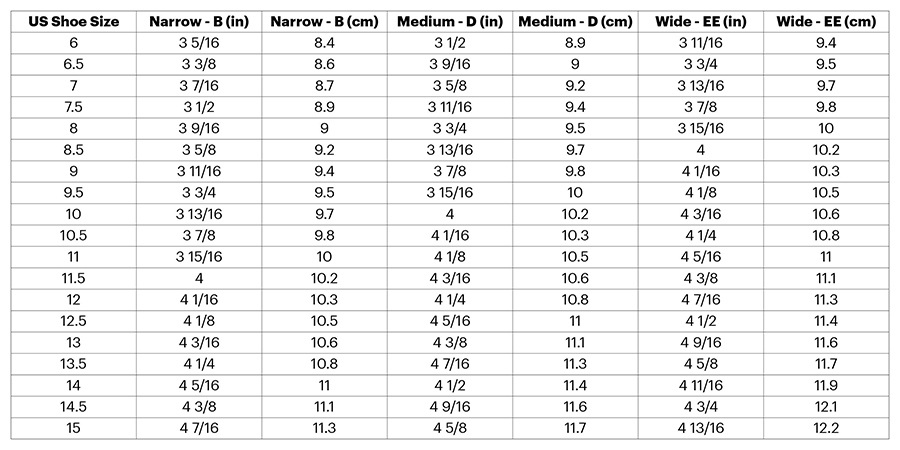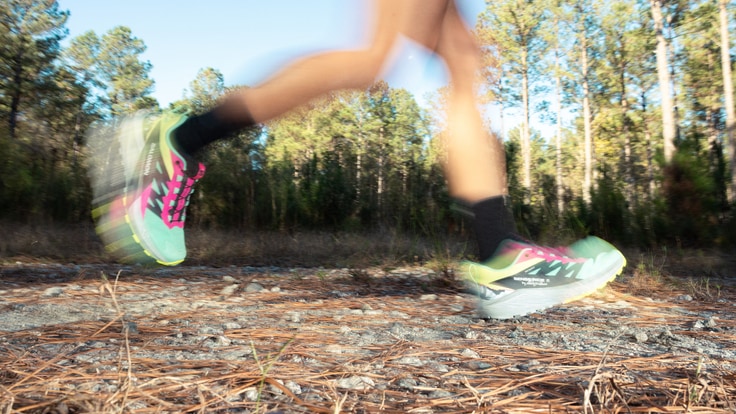If you want to experience hiking trails in a new way or you're an urban runner who wants to vary the routine, the siren call of trail running is hard to ignore. Before you head for the hills, though, you need shoes that are specifically built to venture beyond the pavement. Trail-running shoes differ from road runners in several respects:
Grip on rugged terrain: Lugged soles improve traction to help you move more sure-footedly over dirt, mud, gravel, roots and rock slabs.
Foot protection: A variety of internal and external features help shield feet from impact with rocks and roots. Durable upper materials withstand abrasion and tears.
Stiff construction: Trail runners are built to prevent excessive foot rotation. In addition, because running on trails involves a shorter, more variable stride as you adjust to land where footing is optimal, pronation control isn't a big consideration.
This article covers four topics to help trail runners decide on the best shoes to buy:
- Shoe type: Your options are light trail, rugged trail or off trail
- Cushioning: Choices range from barefoot (none) to maximum.
- Heel-to-toe drop: This measurement affects your running mechanics.
- Fit: Get expert help and be willing to switch your shoe choice because this is your most important consideration.
Video: How to Choose Trail-Running Shoes
Shoe Types
Choosing shoes starts by assessing the type of trails you plan to run on. Make your best guess at this point: If you run regularly, a new pair of shoes will have a life expectancy of four to six months, which is another way of saying that the opportunity to try alternatives won't be far off.
Trail-running shoes fall within three broad categories:
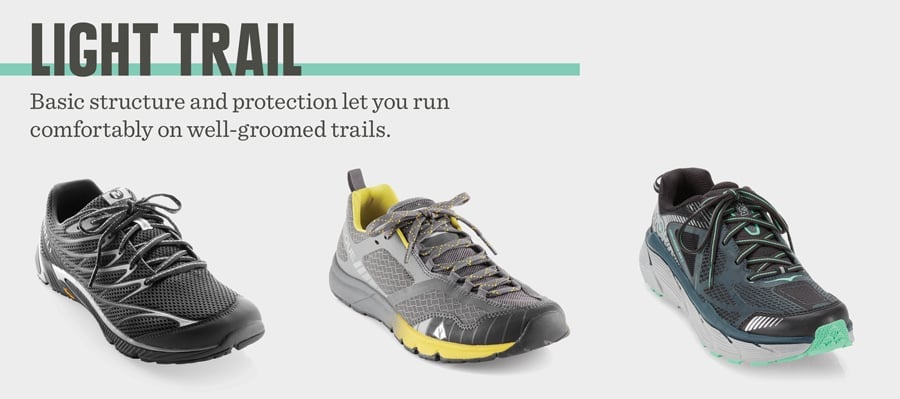
Light Trail
Light trail shoes are designed for relatively uniform surfaces. Think fire roads, gravel paths and rolling hills. These shoes will be the closest in weight and build to road-running shoes. Characteristics of this shoe category include:
- Modest protection from rocks and roots
- Lightweight designs that make it easier to maintain a brisk pace
- Moderately stiff builds that promote stable foot placement
- Soles with shallow lugs that offer traction on packed soil
- In some shoes: ample midsole cushioning that lets you cruise comfortably, mile after mile
- In other shoes: minimal midsole cushioning that lets you feel more in touch with the trail
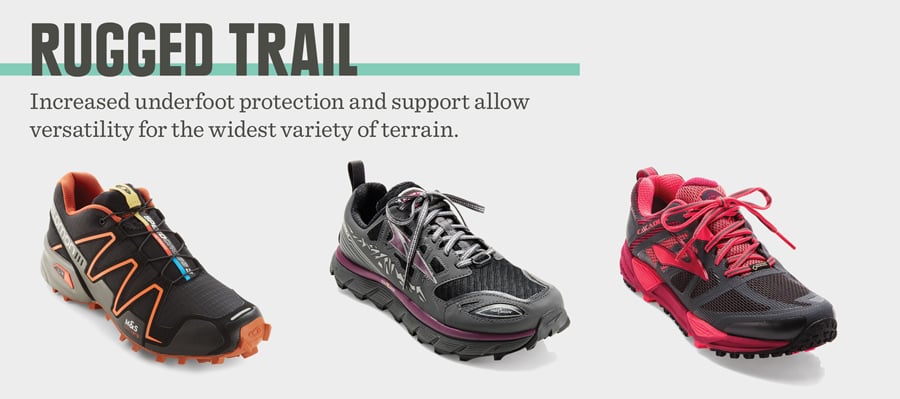
Rugged Trail
Rugged trail shoes are basically designed for running on hiking trails, which can range from a trail engineer's masterwork to an abandoned miner's tract. Thus this category covers the broadest spectrum of terrains. Characteristics may include:
- Toe guards up front and hidden plates underfoot for protection from roots and rocks
- Sturdy materials and overlays for protection against brush and thorns
- Resilient midsole cushioning to absorb footfalls during steep descents and hard landings on rock slabs
- Supportive uppers and stiff builds to stabilize feet on switchbacks and unstable surfaces; some models also include internal shanks, which add stiffness to midsoles
- Diverse lug patterns that provide grip and stopping power at any angle
- Soles with thick, multidirectional lugs for traction on soft soil and mud; wide spacing between lugs allows mud and soft soil to freely drop off
- In some shoes: soft, grippy rubber that resists slipping on wet rock or wood surfaces
- In other shoes: harder, less-grippy rubber that offers greater durability
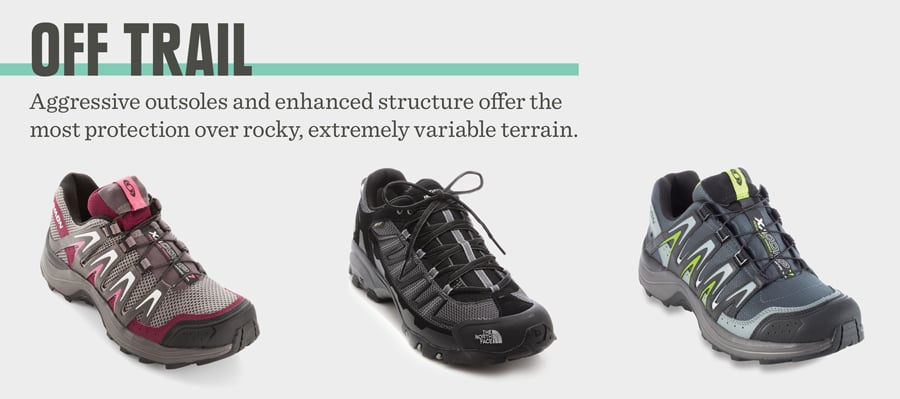
Off Trail
If you plan to run where mortals fear to tread, off-trail shoes are for you. Off-trail shoes offer all of the characteristics listed for rugged-trail shoes, above, with a few enhancements:
- Materials will be more resilient—you might see polyurethane foam midsoles, for example, rather than the EVA foam midsoles found in most rugged-trail shoes.
- Structure will be stouter to provide greater "torsional rigidity," meaning a shoe is less likely to give when a severe twisting force is applied. That's important when very few of your footfalls will occur on flat ground.
- Remote running can take you through streams and bogs and expose you to severe weather, so you'll find more waterproof shoes in this category.
Buying trail runners for hiking, backpacking or thru hiking: Some hikers do this to save weight. That's OK, but be prepared to replace them often. Whether you find them more or less comfortable will depend on pack weight, trail ruggedness and foot toughness. If you decide to do it, look at off-trail models because they offer more durability and support than rugged-trail or light-trail shoes.
Cushioning
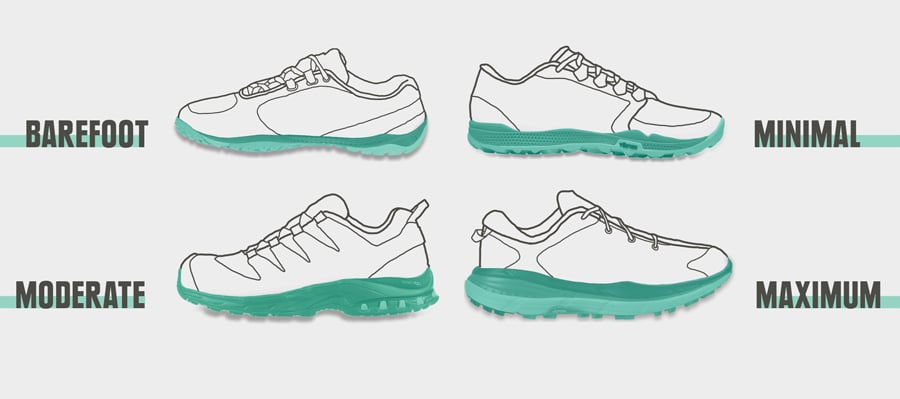
Cushioning level, sometimes referred to as "stack height," remained largely unchanged for many years until shoes with no padding whatsoever revolutionized the industry. A few years after that, a counter trend arose when shoes with massively cushioned midsoles hit the market.
Today, this "feel" vs. "float" cushioning spectrum offers you a wide range of options:
Barefoot: As you might imagine, these are the no-padding shoes. The appeal is that they let you develop an enhanced feel for the trail and your own biomechanics.
Minimal: These shoes are a good option for runners who want a better feel for the trail but aren't comfortable with forgoing all midsole padding.
Moderate: One could characterize these as traditional trail runners, with enough padding to let you comfortably run over rooty and rocky trails.
Maximum: These are the models that offer heaps of padding in the midsole. Devotees say shoes with maximum cushioning are easier on joints and reduce fatigue on high-mile runs. Detractors say that super-soft cushioning in some shoes makes for a "mushy" (less efficient) toe-off as you run.
Heel-to-Toe Drop

Heel-to-toe drop is a measurement that's closely related to cushioning height. Ranging from 0mm to more than 12mm, heel-to-toe drop is the difference between the height at the heel and the height at the forefoot:
- Barefoot shoes have a 0mm drop.
- Minimalist shoes typically have a drop of 0 to 4mm.
- Moderate and maximalist shoes offer a wide range of heel-to-toe drops.
To decide what heel drop will work best for you, consider these tips:
Match the drop of your current running shoes. You'll avoid messing with your body's biomechanics. And be aware that, even if you're buying the same shoe model, you need to double-check the heel drop. Every once in a while, a shoe brand will alter the heel-to-toe drop when it updates a shoe's design.
If you don't have running shoes, look at your other shoes. First look at your other athletic shoes. If you don't have any athletic shoes, then look at your casual shoes. Most shoes will have a moderate heel-to-toe drop, which simply suggests you avoid trail runners that are at or near the 0mm and the 12mm ends of the spec range. If you wear flats or flip-flops all the time, then low-drop shoes might be fine.
A low heel drop encourages a midfoot or forefoot strike. The result is a more stable landing platform, along with better balance and muscle engagement. This beneficial biomechanical shift is a big appeal of barefoot and minimalist shoes. Not everyone benefits from—nor can transition to—a low-drop shoe, though.
If you are considering changing to barefoot or minimalist shoes, take it slow. Plan on a few months of transition time and some discomfort as you make the physical adjustment. To learn more, read barefoot/minimalist running basics.
Note that you can also find shoes with moderate and maximum cushioning that have a low heel drop. Switching from a well-cushioned high-heel-drop shoe to a well-cushioned low-heel-drop shoe is not for everyone. It entails some discomfort and takes a little transition time.
Fit
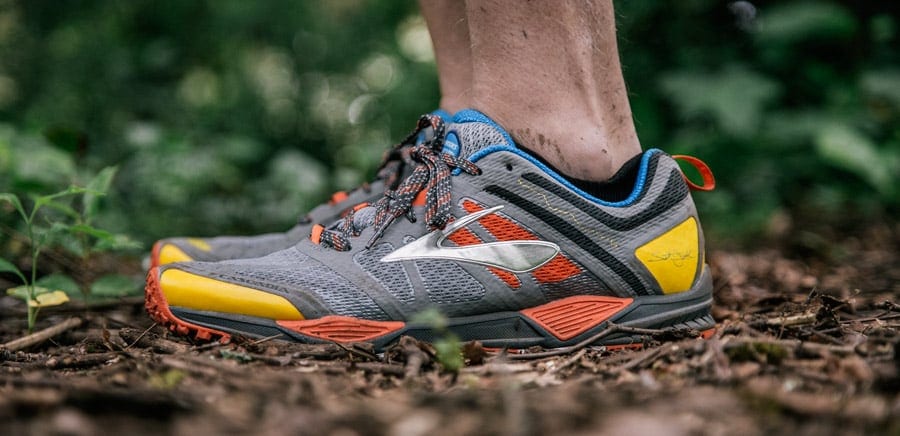
Fit is more important than any other consideration. A shoe that gets rave reviews isn't a great shoe for you unless it fits your foot. And getting a good fit involves more than length and width. Feet are biomechanically complex and a good fit will also account for factors like arch shape, arch length, foot volume and more.
Consider shoe lasts: Each brand builds its shoes around a sophisticated foot form called a "last." Your goal is to find which brands have a last that's similar to your foot. Then you can shop online and have a better chance of getting shoes that fit.
Don't assume you know your shoe size: Your feet change as you age, so it's always wise to get measured. Then you need to account for the fact that your feet swell as you run: You'll want shoes that provide adequate length and width in the toe box.
Get a fit assessment: A footwear specialist can assess the size and shape of your feet and advise you about how different brands fit. Any REI store can do this for you, but you should plan ahead for the best experience. You don't have to make an appointment, but we recommend you pick a less busy time or ask when some of the most experienced footwear staff will be in store. Go later in the day because your feet swell and you can be sure to get shoes that are big enough to fit you properly.
Finally, a footwear specialist can help you walk out with shoes that alleviate a wide range of foot issues, like bunions, hammertoes, plantar fasciitis and more. A specialist can also account for your orthotics or find a premade insole to meet your needs.
Video: How to Size and Fit Running Shoes
Running Shoe Length and Width Size Charts
Measure the length and width of your feet using the tips in the video above, then consult with these size charts to find your perfect fit.
Women's Running Shoe Length Size Chart
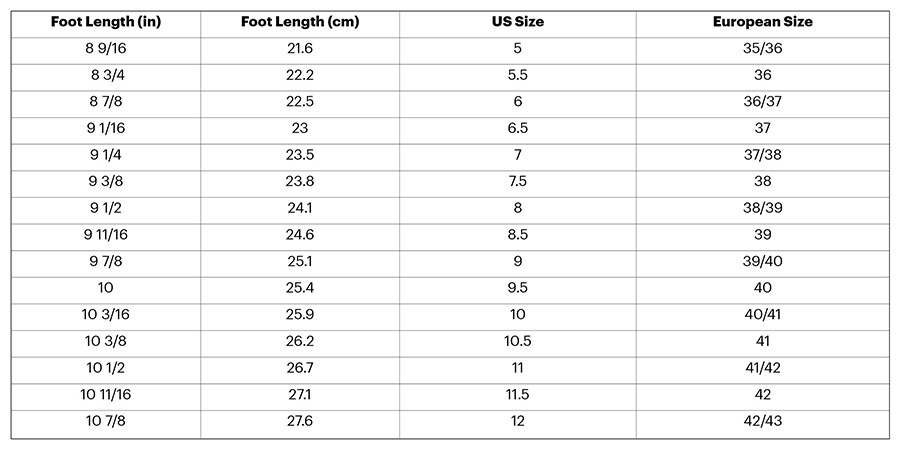
Men's Running Shoe Length Size Chart
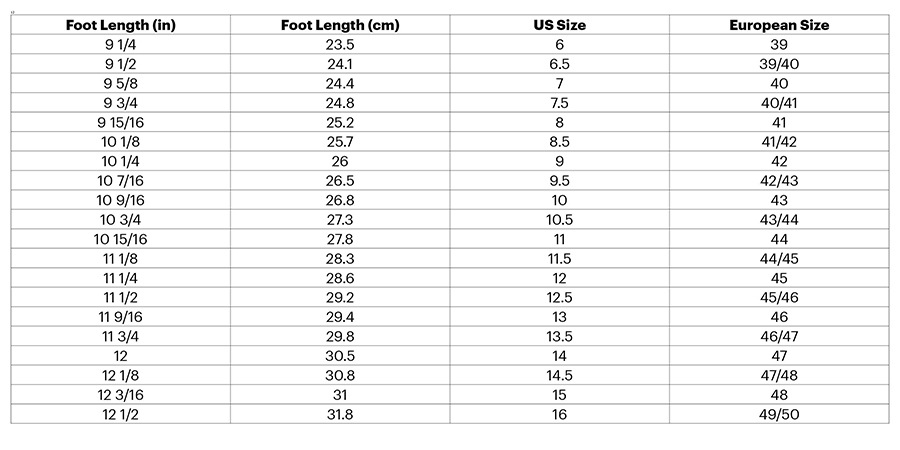
Women's Running Shoe Width Size Chart
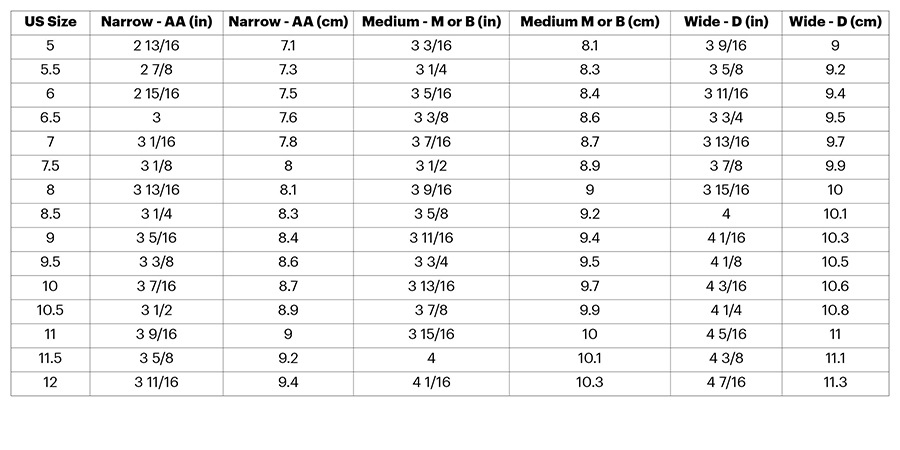
Men's Running Shoe Width Size Chart
